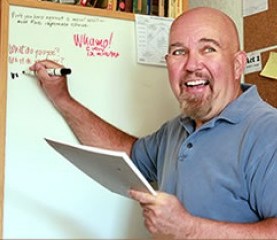(Originally published on Blogcritics.org)
Attendees at AdobeMAX love Sneaks. AdobeMAX brings together users of Adobe software, such as Photoshop, InDesign, Premiere Pro, and Acrobat, with the engineers, developers, and managers responsible for improving and supporting the software. Sneaks, which was co-hosted this year by Parks and Recreation star Nick Offerman, demonstrates currently in-development technology, which may or may not work its way into products.
Offerman, who is an avid woodworker, was joined by Adobe communications manager, and marathon swimmer, Kim Chambers to introduce the cutting-edge tech. Between presentations, Offerman and Chambers engaged in tongue-in-cheek banter.
Offerman employs Adobe software in his woodshop to help with design. He joked that he was unfamiliar with the software and only his “people” used it. (At least I think he was just joking.) He referred to Photoshop as “Photolab” throughout the presentation. By the end of the session, even the Adobe techs were using, to much laughter, the term “Photolab.”
Before the demonstrations began, Adobe showed video of Chambers’ swimming exploits. After watching it, Offerman commented, “There’s a badass on stage and then there’s a fellow with a beard.”
They finally got to the tech. Note that the hashtagged names of the new technology can be searched on the web to find video demos.
#Louper. We know we can search the web by typing or by voice. Adobe is working on a new way: by image. Louper allows you to take an image and search for other images similar in style, color and composition. You can even search with two images, such as a drawing and a color wheel, to find drawings with a particular color palette to fit your design project. This is much faster and more intuitive than trying to describe in words what you’re looking for.
#3dportraits. Three dimensional printing is becoming fairly well known. Adobe is pushing this one step further with 3-D portraits. For the demo, a photo of Offerman was used to create the 3-D image in Photoshop. The actual printing was performed earlier; it would have taken about 45 minutes. Offerman liked the results. “It’s hunk-a-fying,” he said, modestly.
#ByeByePhotobomb intelligently automates tasks that can already be performed in Photoshop with tools such as the healing brush, but does it in seconds, instead of requiring time-intensive work. The tool analyzes the picture, then, as you move a slider, begins to delete and patch background objects and other parts of the image that it has identified as not the focus of the photo. If it removes too much, you can just move the slider back to restore that part of the image.
#MonumentMode does the opposite of #ByeByePhotobomb. Let’s say you want to take a picture of the Eiffel Tower, but tourists keep walking in front of it. The solution is to take several pictures as people move around. Then #MonumentMode will remove the non-repeating elements – in this example, the meandering tourists – leaving only the background, the monument.
#ProjectBoxcar: Adobe software will already seamlessly condense a piece of music to fit the length of a video clip. #ProjectBoxcar seeks to improve this. It can take an existing musical work and modify it so that it changes in response to changes in the visuals within the video. For instance, you have a video which contains a train, which goes into a tunnel, then emerges from the other end of the tunnel back into the sunlight. This software tool, using elements already in the music, can modify the musical piece to go from upbeat while the train is outside, to low and muted when it is in the tunnel, back to upbeat when it emerges from the other side.
#Deepfont and #ProjectFaces: Designers often spend a lot of time finding the right font for a project. Adobe demonstrated two projects with the potential to help. #DeepFont analyzes a picture of a letter, in the case of this demo a hand-carved letter from Offerman’s woodshop, and searches for a font that matches it. #ProjectFaces is a tool that lets you design your own font in amazing detail.
Whether any or all of these tools make it to production software is not guaranteed, but I suspect most of them will. Offerman summed things up: “I feel so deliciously dumb right now. This is crazy future stuff.”
True, but hopefully, not too far in the future.



